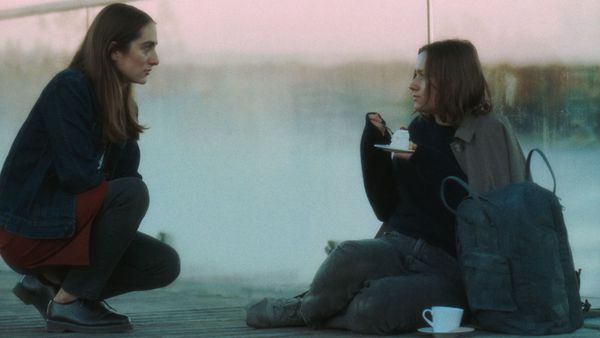Eye For Film >> Movies >> Johatsu (2024) Film Review
Johatsu
Reviewed by: Marko Stojiljkovic

Since it emerged in Greece during the financial crisis, the so-called 'weird wave' has mutated across different national cinemas in Europe. In many countries, that 'wave' was merely a brief 'splash', but two countries went on the create their own versions of the proper 'wave'. The Finnish one is visually and even emotionally much warmer than the original Greek iteration, while the Lithuanian one, emerging to scoop prizes in recent years, is weirder than both. Do yourself a favour and check films like The Runner, Pilgrims and this year’s Locarno laureate Toxic. Its newest representative is Johatsu, which has just premiered in the Critics’ Picks slot at Black Nights.
The term itself is, however, Japanese. It means the sudden and unexplained disappearance of a person out of their own desire. It is not simply a change of routine, a distraction or a retreat, but the wish to change life completely and permanently that results in action. Also, it is not a philosophical, theoretical concept, but a real-life phenomenon currently rising to the level of an epidemic, pictured in this year’s documentary Johatsu: Into Thin Air, by Andreas Hartmann and Arata Mori.

Here, we have Lina (The Runner’s Zygimante Elena Jaskataite) who has no reason to be unhappy with her life, since she has somewhere to live, a boyfriend Tomas (Laurynas Jurgelis), who loves her, and a job that she finds fulfilling. Others might see working as an orderly at the Vilnius city morgue as something weird or disturbing, but Lina actually likes the peace and the 'realness' of her clients.
Until one day, when an explosion at a coastal town destroys a ship, kills one sailor and leaves another one missing. A corpse is identified as Vilkas, one of the sailors, by his wife. However, Lina is not persuaded, so she starts her own investigation hoping to find Vilkas, who deserted his family years earlier, alive somewhere. The path leads her to the shady port town, where every trace opens up more questions and mysteries. Just as she is after Vilkas or the idea of Vilkas, someone else is after her. But the strangest thing is – she starts the feel the urge for her own 'johatsu'.
The trouble with the film is that the string of events it pictures makes exactly zero sense, either as a human drama or as a tense and dense thriller. This could be quite a deliberate move from the directing duo comprised of a documentarists Nerijus Milerius and Lina Luzyte, but that does not make their metaphor any less farfetched. The necessary ingredients for both of the intended genres are the ability to involve the audience and relatability, and Johatsu lacks in both.
Basic coherence is lacking. Sure, Lina feels the change and somehow magically changes from a relentless young woman capable of serving her drunk boss with a monologue which is actually her darkest scenario for his future to a mousy creature who has no idea what to do when her 'investigation' stumbles, but also has no idea of her own limitations in doing the work that is not hers. A capable actress can do only so much to make herself watchable in a movie that is often not.
However, there are two related things that could be considered the film’s saving grace. Firstly that is a dark, gloomy and uncertain atmosphere that channels a dash of surrealism and suits the thriller genre pretty well. The other thing is the impeccable and often impressive camerawork of Vytautas Katkus, who also shot Toxic. This time, however, the colours are more saturated, adding an surreal quality. In the end, Johatsu's reach is lower than its aim, as the superficially intriguing flick does not live up to its potential and the filmmakers’ ambitions.
Reviewed on: 22 Nov 2024
















